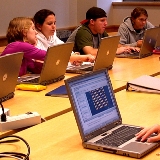Ετικέτα: teachers – instructors
Why BYOD is BAD
Educators Work To Better Integrate Technology Into The Classroom

By Amy Golod May 2, 2012
American university professors do not teach education students a universal, tried-and-true method for how to incorporate technology in their classroom instruction. That the digital revolution evolves at a rapid pace and that technology has become so subject-specific means universities cannot address these shifts and create a standard curriculum. As a result, educators have become more resourceful and ingenious in their teaching, professors say.
“Large-scale studies show that the technology itself doesn’t necessarily make a difference. What does make a difference is well-designed technology coupled with well-prepared teachers,” says Prof. Steve Kerr, chair of curriculum and instruction at the University of Washington’s College of Education in Seattle.
Integration of technology in the classroom is an issue with which higher education schools have been grappling for decades, he says.
There are two main approaches on university campuses. Some curricula for undergraduate and graduate programs in education mandate that pre-service teachers–students who have not yet entered the field–enroll in one course that focuses only on technology. The second tactic emphasizes subject-specific courses that include guidance on how technology may enhance understanding of concepts related to those academic subjects.
The latter, specific strategy seems to be favored, explains Joan Hughes, associate professor of curriculum and instruction and learning technologies at the University of Texas-Austin, adding that when tech skills are taught this way, in isolation from other teaching methods, they are less effective.
Marina Pita, a teacher of fourth-grade Spanish at Concord International School in Seattle, distinctly remembers instruction in the latest digital products as part of her classes. During a course on special education, she learned about assistive technology, and as part of her elementary teacher certification, she received training in the computer-based Smart Boards, which allow teachers to project lessons onto a wall for all to follow. Since then she has seen the value of such training firsthand.
Her district does not have the resources to supply a Smart Board, so instead she relies on the desktop computers in the school library—anything to keep her lessons current. “Computer skills are so important, especially for kids growing up in a digital age. Some of my students hardly know how to use a mouse or save a document, and this is so critical for success in the workplace today,” she said.
While some university courses offer this specific training, others put the onus on the students. Professors assign projects that focus on academic subject specialties, but require a digital presentation as a means of including exposure to technology.
Eric Miller, a teacher of sixth-grade social studies at Eckstein Middle School in Seattle, remembers a graduate school project for which he created a website to teach a history lesson. The website asked users about the assassination of President John F. Kennedy and provided links to other websites. Users would click on the links to read both related and unrelated information and then sort out the correct response.
“My first experience using technology in education ended up being a common trend for quite some time,” Miller says. He later learned that WebQuest, a company popular in education circles during the late 1990s and early 2000s, promoted these inquiry websites.
After they have completed their certification, teachers can turn to universities for supplementary instruction on the most recent trends.
For example, Tufts University Center for Science and Mathematics Teaching organizes workshops and resources for pre-service and practicing teachers on how best to incorporate technology in their lessons. It designs curricula, providing examples of lessons and correlating homework assignments.
“When we have powerful tools and an active curriculum, it helps with the comprehension,” says Ronald Thornton, a professor in both physics and education at Tufts University and director of the Tufts Center for Science and Mathematics Teaching.
Αρχαία Ελληνική Τεχνολογία – Ο υπολογιστής των Αντικυθήρων
Τεχνολογία στα σχολεία: Ναι αλλά με τη δική σας συσκευή!
Mini site για εκπαιδευτικούς, μαθητές, γονείς και κηδεμόνες

